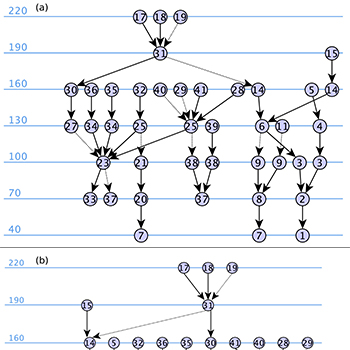A kinship network analysis of Palmyrene genealogies
DOI:
https://doi.org/10.25517/jhnr.v6i1.65Keywords:
Palmyra, portraits, genealogy, kinship, archaeologyAbstract
In this paper we study the potential and challenges of a formal network approach for the study of 1st to 3rd century AD kinship networks in ancient Palmyra (in present-day Syria). The recent availability of a large digitised archaeological dataset allows for a thorough reassessment of previously studied genealogies, and applying network and genealogical formal methods to these for the first time allows us to explore new questions: what is the genealogical completeness and gender bias in our sources, and to what degree was there a tendency for intermarriage within the extended family?
We combine archaeological information from funerary portraits in the exhaustive database by the Palmyra Portrait Project with textual sources from funerary and public inscriptions, and critically evaluate the differences and limits of these sources for genealogical studies. Applying formal network and genealogical techniques to these datasets and comparing between five different case studies allows us to draw four key conclusions: (1) our sources reveal a high degree of genealogical incompleteness and gender bias; (2) the relinking index can enhance debates on endogamy and exogamy practices in ancient societies; (3) funerary and public inscriptions are highly complementary, and reveal different genealogical structures; (4) the assumptions behind creating uncertain relationships in funerary cases and their effects on quantitative results require careful qualitative scrutiny.
This proof-of-concept study highlights the strong potential of this formal network approach for the study of ancient genealogies. It demonstrates a number of quantitative and qualitative approaches for understanding the limits of fragmentary archaeological and historical sources in this process, and it lays the foundation for formulating highly specified hypotheses about the structure of ancient Palmyrene kinship networks in future work.

Published
How to Cite
Issue
Section
License
A Creative Commons Attribution-NoDerivatives 4.0 (CC BY-ND 4.0) license applies to all contents published in JHNR. While articles published on JHNR can be copied by anyone for noncommercial purposes if proper credit is given, all materials are published under an open-access license with authors retaining full and permanent ownership of their work. For details please consult the Open Access and Copyright Notice.

